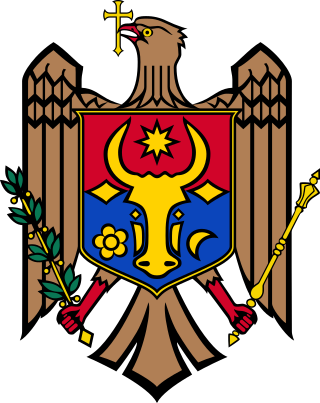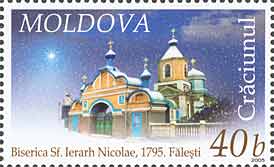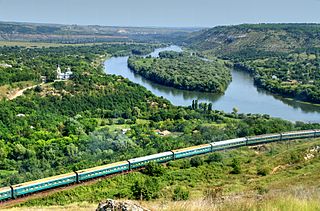
Moldova, officially the Republic of Moldova, is a landlocked country in Eastern Europe. It is bordered by Romania to the west and Ukraine to the north, east, and south. The unrecognised state of Transnistria lies across the Dniester river on the country's eastern border with Ukraine. Moldova's capital and largest city is Chișinău.

Transnistria, officially the Pridnestrovian Moldavian Republic (PMR), is an unrecognised breakaway state that is internationally recognised as a part of Moldova. Transnistria controls most of the narrow strip of land between the Dniester river and the Moldovan–Ukrainian border, as well as some land on the other side of the river's bank. Its capital and largest city is Tiraspol. Transnistria has been recognised only by three other unrecognised or partially recognised breakaway states: Abkhazia, Artsakh and South Ossetia. Transnistria is officially designated by the Republic of Moldova as the Administrative-Territorial Units of the Left Bank of the Dniester or as Stînga Nistrului. In March 2022, the Parliamentary Assembly of the Council of Europe adopted a resolution that defines the territory as under military occupation by Russia.

According to the Moldovan law on territorial administrative organisation, Moldova is divided administratively into the following administrative territorial units: districts, cities/towns and villages. The administrative territorial organization of Moldova is made on 2 levels:
- villages (communes), sectors and cities/towns (municipii) constitute the first level,

Cahul is a city and municipality in southern Moldova. The city is the administrative center of Cahul District; it also administers one village, Cotihana. As of 2014 census, the city has had a population of 30,018.

Moldovans, sometimes referred to as Moldavians, are a Romanian-speaking ethnic group and the largest ethnic group of the Republic of Moldova and a significant minority in Ukraine and Russia. There is an ongoing controversy, in part involving the linguisitic definition of ethnicity, over whether Moldovans' self-identification constitutes an ethnic group distinct and separate from Romanians, or a subset. The extent of self-identification as Romanians in the Republic of Moldova varies.
Nisporeni is a city in and the administrative center of Nisporeni District in Moldova.

Căușeni is a town and the administrative center of Căușeni District, Moldova.

Fălești is a city and the administrative center of Fălești District, Moldova.

Giurgiulești is a commune in the Cahul District of Moldova. It is also a border crossing point to Romania, located 10 km (6.2 mi) from Galați.

Otaci is a town on the southwestern bank of the Dniester River, which at that point forms the northeastern border of Moldova. On the opposite side of the Dniester lies the Ukrainian city of Mohyliv-Podilskyi, and the two municipalities are connected by a bridge over the river. Otaci is located in Ocnița District.
Palanca is a village in Ștefan Vodă District, Moldova, near the border with Ukraine. Situated at a longitude of 30°06' east, it is the country's easternmost point and lowest point.

Naslavcea is a village in Ocnița District and the northernmost point in Moldova. The village, situated along the Dniester river that separates Moldova and Ukraine, has an ethnic Ukrainian majority.
Bălănești is a commune in Nisporeni District, Moldova. It is composed of two villages, Bălănești and Găureni.
Leușeni is a commune in Hîncești District, Moldova. It is composed of two villages, Feteasca and Leușeni.
Costeşti is a city in Rîșcani District, in northern Moldova.

Sîngera is a town in Chișinău municipality, Moldova. In addition, two villages are administered by the town, Dobrogea and Revaca. At the 2004 Moldovan Census, the population of the town itself was 7,354, that of Dobrogea, 3,279, and Revaca, 976. The total population was 11,609. At this point in Singera functioning church in honor of the Holy Righteous Joachim and Anna.

Ocnița is a town and the administrative center of Ocnița District, Moldova.

Rudi is a village in Soroca District, Moldova.
The 2014 Moldovan census was held between 12 and 25 May 2014. It was organized by National Bureau of Statistics of the Republic of Moldova.
According to the Moldovan law on territorial administrative organisation, two or more villages can form together a commune.















